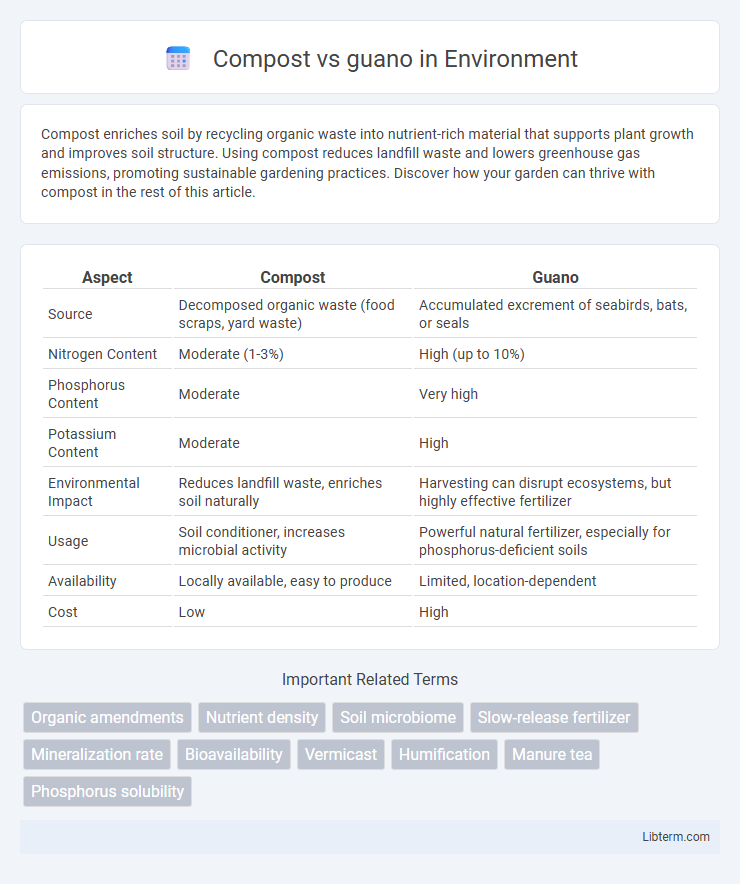Compost enriches soil by recycling organic waste into nutrient-rich material that supports plant growth and improves soil structure. Using compost reduces landfill waste and lowers greenhouse gas emissions, promoting sustainable gardening practices. Discover how your garden can thrive with compost in the rest of this article.
Table of Comparison
| Aspect | Compost | Guano |
|---|---|---|
| Source | Decomposed organic waste (food scraps, yard waste) | Accumulated excrement of seabirds, bats, or seals |
| Nitrogen Content | Moderate (1-3%) | High (up to 10%) |
| Phosphorus Content | Moderate | Very high |
| Potassium Content | Moderate | High |
| Environmental Impact | Reduces landfill waste, enriches soil naturally | Harvesting can disrupt ecosystems, but highly effective fertilizer |
| Usage | Soil conditioner, increases microbial activity | Powerful natural fertilizer, especially for phosphorus-deficient soils |
| Availability | Locally available, easy to produce | Limited, location-dependent |
| Cost | Low | High |
Introduction to Compost and Guano
Compost is a nutrient-rich organic matter produced by the decomposition of plant and food waste, enhancing soil health and fertility. Guano, composed primarily of seabird or bat excrement, is a highly concentrated natural fertilizer loaded with nitrogen, phosphorus, and potassium. Both compost and guano serve as effective soil amendments but differ significantly in nutrient content and environmental origin.
What is Compost?
Compost is a nutrient-rich organic matter created through the controlled decomposition of food scraps, yard waste, and other biodegradable materials. It enhances soil structure, moisture retention, and microbial activity, promoting healthy plant growth. Unlike guano, which is a specific fertilizer made from accumulated bat or bird droppings, compost provides a balanced source of macro and micronutrients essential for sustainable gardening and farming.
What is Guano?
Guano is a highly concentrated natural fertilizer composed primarily of accumulated seabird or bat excrement, rich in nitrogen, phosphorus, and potassium essential for plant growth. Its unique nutrient profile makes it an effective organic amendment that enhances soil fertility and promotes robust crop yields. Unlike compost, guano offers faster nutrient release, making it ideal for rapid plant development and soil enrichment.
Nutrient Profiles: Compost vs Guano
Compost typically contains a balanced mix of macronutrients including nitrogen (N), phosphorus (P), and potassium (K), with variable micronutrients depending on the source materials, offering slow-release nutrients that improve soil structure and microbial activity. Guano, derived from bat or seabird excrement, is exceptionally high in nitrogen and phosphorus, often with concentrations exceeding 10-12% N and 8-10% P, providing a potent and fast-acting fertilizer ideal for rapid plant growth. While compost enhances overall soil health and nutrient retention, guano delivers immediate, concentrated nutrients but may require careful application to avoid nutrient burn.
Application Methods Compared
Compost is commonly applied as a soil amendment by incorporating it into the topsoil, promoting long-term nutrient release and improved soil structure. Guano, rich in nitrogen and phosphorus, is frequently used as a concentrated fertilizer applied directly to planting rows or mixed into seedbeds for rapid nutrient uptake. Application rates and timing vary, with compost suited for broad soil enrichment and guano favored for targeted, quick-release fertilization in vegetable and flower gardens.
Environmental Impact of Compost and Guano
Compost reduces landfill waste by recycling organic materials, lowering methane emissions and improving soil health through increased microbial activity and carbon sequestration. Guano, while natural and rich in nitrogen, phosphorus, and potassium, often involves ecosystem disruption due to harvesting from bird colonies, potentially threatening biodiversity. Compost serves as a sustainable fertilizer alternative by enhancing soil structure and moisture retention without the ecological risks associated with guano extraction.
Cost and Availability
Compost typically offers a lower-cost option due to its accessibility from organic waste materials and local production, making it widely available to gardeners and farmers. Guano, derived from the accumulated excrement of seabirds and bats, often commands a higher price because of its concentrated nutrients and limited supply. Availability of guano is geographically restricted to areas near caves or coastal regions, whereas compost can be produced virtually anywhere.
Suitability for Different Plants
Compost provides a balanced nutrient profile ideal for most vegetables, fruits, and flower gardens, improving soil structure and moisture retention. Guano, rich in nitrogen, phosphorus, and potassium, is highly suitable for nutrient-demanding plants like tomatoes, peppers, and flowering plants that require rapid growth and abundant blooms. While compost supports long-term soil health for a wide range of plants, guano delivers a potent nutrient boost for specific crops needing enhanced flowering or fruiting.
Pros and Cons: Compost vs Guano
Compost enriches soil with diverse nutrients, improves soil structure, and is sustainable but requires time to decompose and may vary in nutrient content. Guano provides a high concentration of nitrogen, phosphorus, and potassium, promoting rapid plant growth but can be expensive and may cause nutrient burn if overused. Choosing between compost and guano depends on the desired nutrient release rate, cost considerations, and soil health goals.
Which is Best for Your Garden?
Compost and guano both enrich soil, but their benefits depend on garden needs; compost improves soil structure with balanced nutrients derived from decomposed organic matter, ideal for overall soil health and long-term fertility. Guano, rich in nitrogen, phosphorus, and potassium, acts as a potent, natural fertilizer promoting rapid plant growth, particularly beneficial for nutrient-deficient soils or flowering plants. Selecting between compost and guano depends on whether the priority is enhancing soil quality over time or providing a quick nutrient boost for specific growth stages.
Compost Infographic

 libterm.com
libterm.com